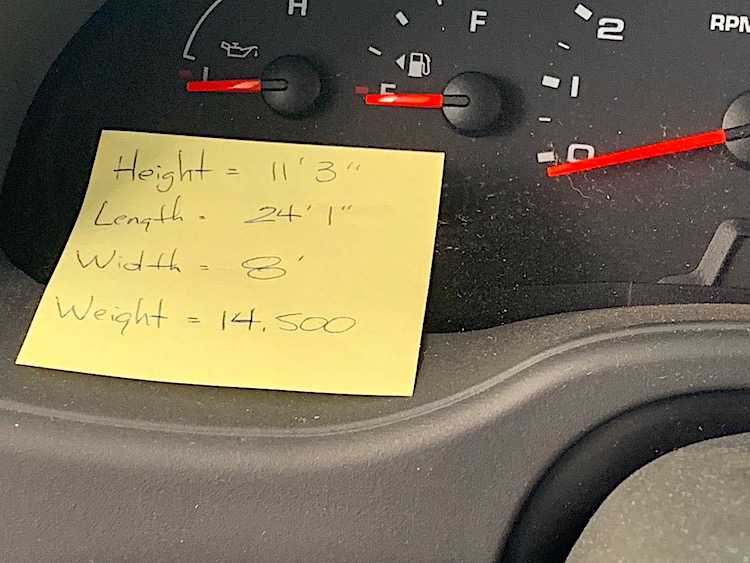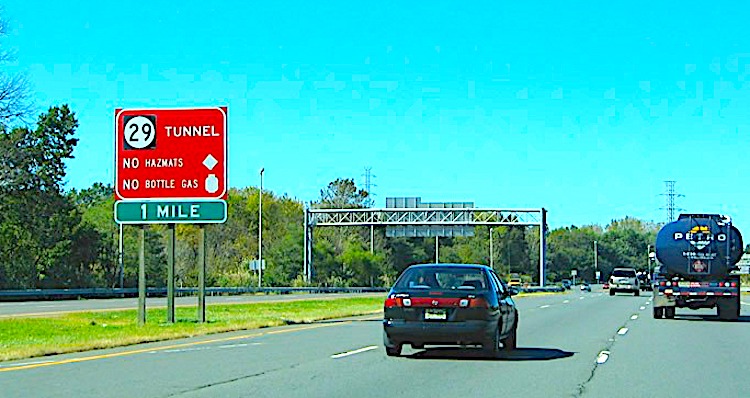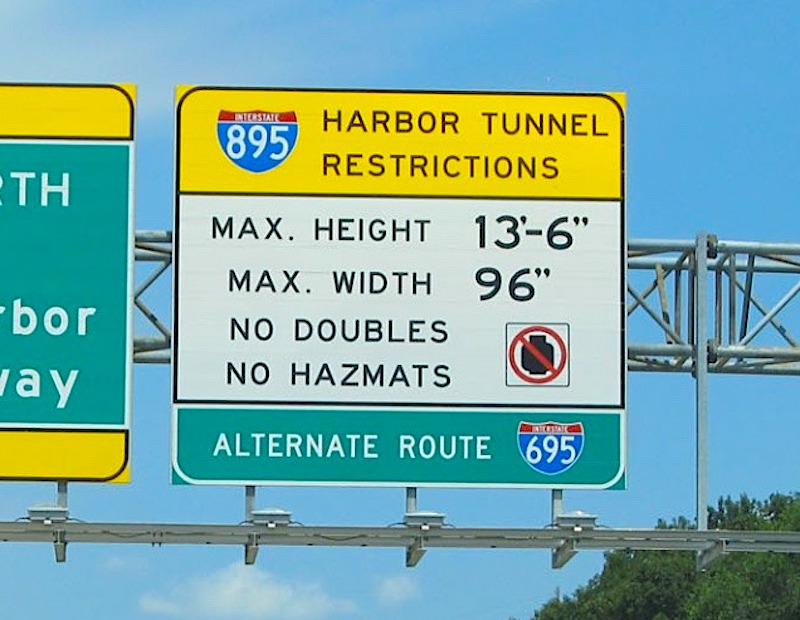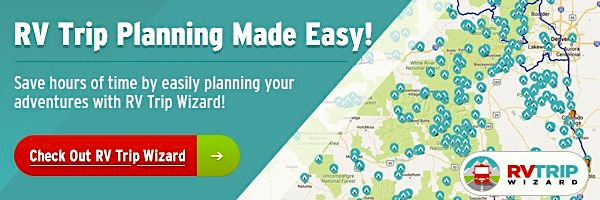Thanks for your support! If you make a purchase using our links in this article, we may make a commission. And, as an Amazon Associate, I earn from qualifying purchases. See the full disclosure here.
Planning a big road trip can be a lot of fun but can sometimes cause anxiety. If you are new to RV life or planning a big trip, you may wonder if there are any restrictions on RV travel that you need to know about. Many RVers are often curious about rules and restrictions when it comes to bridges and tunnels.
We saw a question in a Facebook group and it made us wonder: Are RVs Allowed to Go Through Tunnels?
When it comes to taking your RV through a tunnel, several key factors could impact your ability to pass through the tunnel with ease. Factors that you need to consider are the height of your RV, the width of your RV, and whether or not you have propane tanks on board.
While in general, RVs are allowed on most roads and bridges, as well as tunnels, there are some tunnel restrictions that you need to know. So read on to learn if RVs are allowed to go through tunnels.
Tunnel Restrictions
Let’s take a closer look at the three main types of tunnel restrictions.
1. Height
While most newer tunnels were built to accommodate vehicles as tall as 13 feet, older tunnels may or may not be large enough to accommodate vehicles of this size. Any time you know that you will be going through a tunnel, it is wise to figure out the height restrictions in advance. You will also want to be sure that you know the exact height of your RV before you set out on your trip.
Knowing the exact size of your RV is essential when traveling. It is best to carefully determine the height and width of your RV before leaving on your first trip. Be sure to write down the exact dimensions of your rig and put the information in a safe, easy to reach place. We recommend placing these measurements in your glove compartment or storing them in your phone. Another good spot is to put them right over the gage area in front of your steering wheel.

Another option is an RV GPS. If your RV is very large, you may want to consider purchasing an RV GPS. An RV GPS is designed to notify you about tunnels and bridges on your route that are too low or narrow for you to pass through safely. You can enter the exact specifications of your rig to get this information in advance of your trip.
Even if you are using an RV GPS, you will still want to check the restriction signs when you approach a tunnel to be sure that the information from your GPS is correct. Always double-check the height and width restrictions before entering a tunnel.
When approaching a tunnel, be on the lookout for signs with maximum height restrictions. These signs are usually posted in advance of the tunnel and on the entrance to the tunnel as well. If you are unsure about your ability to pass through the tunnel safely, find an alternate route. It is always better to be safe than sorry.
2. Width
Modern tunnels are designed to accommodate vehicles as wide as 8.5 feet. 8.5 feet is enough space for most RVs to safely pass through with ease. Many older tunnels may not be able to accept this width of vehicle. It is essential to check the width restrictions as well as the height restrictions before entering a tunnel.
Again, as with the height, any restrictions on travel will be posted on the road in advance of the tunnel. Restrictions will also be displayed at the tunnel entrance. If your RV is too wide to pass through the tunnel safely, you will need to find an alternate route.
If you are touring the great national parks of the western United States, there is one interesting tunnel travel option that you will want to be sure to note. If you are planning to visit Zion National Park, your travels may take you through the 1.1-mile Zion-Mount Carmel Tunnel. This popular tunnel provides access to Bryce Canyon and the Grand Canyon from Zion National Park and has an oversize vehicle policy that you need to know.
In recent years the tunnel had a lot of accidents with large vehicles passing through the tunnel. While the vehicles met the width requirements, the Federal Highways Administration found that larger vehicles could not handle the many curves through the tunnel without crossing the centerline. This problem has been solved by converting the tunnel to restricted one-way access when larger vehicles need to pass through. Converting the tunnel to one way when needed has reduced the number of accidents in the tunnel. It has also made traveling through the tunnel with an RV much more pleasant.
In order to pass through the tunnel with an RV, you will need to pay a $15 tunnel permit fee. The permit fee will allow you to pass through the tunnel as a one-way road, making it much safer for everyone. RVs are allowed to pass through the tunnel from 8:00 a.m. to 4:30 p.m. year-round with longer hours during the summer months. Be sure to check the hours for one way travel before planning to travel through the tunnel.
3. Propane

Many tunnels restrict LP propane in them due to safety concerns. The reason that propane tanks are not allowed in many tunnels is that propane is heavier than air, and tunnel authorities are concerned about propane pooling at the bottom of a tunnel. Although most tunnels have ventilation systems, propane is often prohibited within them out of an abundance of caution.
What is the Difference Between Uphill Tunnels and Downhill Tunnels?
You may be surprised to learn that propane restrictions in tunnels often depend on whether the tunnel is considered to be uphill or downhill.
Most mountain tunnels go uphill then down, which prevents any potential propane pooling in the tunnel. Tunnels that go under the water typically go downhill then up, which creates the potential for propane to pool at the bottom of the tunnel.
The uphill design of most mountain tunnels is why you will find few to no propane restrictions in these locations. In contrast, nearly all downhill (under the water) tunnels either prohibit or restrict LP propane within the tunnel.
If you are passing through a tunnel that allows RVs and propane tanks but has restrictions in place, there are simple steps to follow for a safe journey. At tunnels such as the Chesapeake Bay Bridge-Tunnel, you will need to pull over at a designated spot for RVs before entering the tunnel. Once you are pulled over safely, you will need to get out of your rig and make sure that your propane tank is completely turned off. You will also need to inform an inspector at the tunnel that your tanks are shut off before entering.
If it is necessary to shut off your tanks before entering a tunnel, you will see a lot of signs letting you know about the restrictions. There will also be a well-marked location for you to pull over and check or shut off your tanks before entering the tunnel.
Which Tunnels Don’t Allow Propane?
Because individual states regulate highways and tunnels, you will need to check the RV/propane policies for each state and tunnel that you plan to visit. Each state or tunnel authority sets the rules for RVs, and propane in tunnels and procedures can vary.
The following popular tunnels prohibit LP gas. You will see signs as you approach each of these tunnels for convenient alternate routes for RVs. Many thanks to John Chance who commented below. I added some of the tunnels in his list to our list of tunnels too!
⛔️ Prohibited Tunnels in Arizona
- I-10 thru Phoenix, AZ. Park deck tunnel.
⛔️ Prohibited Tunnels in Kentucky/Tennessee
- US 25E tunnel at Cumberland Gap between KY and TN
⛔️ Prohibited Tunnels in Maryland:
- Baltimore Harbor and Fort McHenry (I-95) tunnels – Alternate route for RVs with propane over the Francis Scott Key Bridge is I-695.
⛔️ Prohibited Tunnels In Massachusetts:
- Massachusetts/Boston Harbor: All tunnels prohibit propane
⛔️ Prohibited Tunnels In New York and New Jersey:
- Brooklyn Battery Tunnel (East River between Manhattan and Brooklyn)
- Queens Midtown Tunnel (East River between Manhattan and Queens)
- Holland Tunnel (Hudson River between Manhattan and Jersey City
- Lower level George Washington Bridge (I-95 South), George Washington Bridge Expressway, Lower level Verrazano Narrows Bridge (Hudson River between Manhattan and Fort Lee)
- Lincoln Tunnel (between Manhattan and Weehawken
⛔️ Prohibited Tunnels in Texas
- Texas/Houston Ship Channel: Washburn Tunnel between Pasadena and Galena Park
⛔️ Prohibited Tunnels In Canada
- Montreal tunnel – use the Hwy 30 bypass, its shorter/faster but does have a small toll.
Conclusion
While it may seem intimidating at first, in general, it is easy to drive your RV through most tunnels or find an alternate route to avoid them altogether. Remember to err on the side of caution and avoid any tunnels that you fear will not accommodate your RV. A little advance planning, double-checking your dimensions, and common sense will keep you safe when navigating tunnels.




RVs are also prohibited on any road in NY that is called a “parkway”. There are likely no signs about this, only signs that state no commercial vehicles. Don’t even think that you can go on them because you’re not a commercial vehicle! The reason is that many bridge underpasses are semi-circles less than 11 feet high in their centers as well as narrow lanes without shoulders. Furthermore, I am not aware of any GPS devices or software that will either warn you about this or automatically route you onto a road without those restrictions. The traffic fines for driving an RV on a parkway are substantial even if you don’t encounter a bridge. The approved roads are local with narrow lanes, traffic lights, slow speeds and lots of lovely, low hanging, tree branches out to damage your RV’s roof and sides. In NY, keep on the interstates, even if they’re toll, for as long as you possibly can.
Thank you for great info. As you mentioned, a good RV/TRUCK GPS should provided some warnings or guidance.
Enjoyed this article!
Hi, we live in Maryland and travel the I95 tunnel through Baltimore with our RV several times a year. The propane restriction is for commercial vehicles and not RVs. I have asked at the entrance at the toll booth to verify this.
The 25E tunnel between TN and KY only require propane tanks be turned off.
Does the propane restriction apply to rvs with built in propane tanks ?
Just passed through Phoenix westbound and did not see any indication about propane in the tunnel
There are really neat narrow, tunnels on the road thru the Needles in S. Dakota. Often this is part of going to Mt. Rushmore. Just a bit further down the road. Several signs posted indicating NO RV’s, TRAILERS, ETC. But often enough folks don’t pay attention. Then that causes traffic jams, and a very astute driver to back that beast, and perhaps get it turned around. Go to YouTube to view all of the ones that had to do this. NOT FUN.
You might add a supplement on ferries. I ran into that crossing from the Olympic Peninsula across to Seattle, WA. I was just asked me to turn of the propane tanks as they measured the RV’s length. That might not be the same all over.
We travel through the 25E tunnel at Cumberland Gap several times every year (we live in KY.) As long as your propane is turned off, you can drive through the tunnel with a motorhome or trailer.
My experience is that the Chesapeake Bay Bridge-Tunnel allows RV’s with propane as long as the bottles are off. They always ask at the toll booth if your propane is off. I tow an RV trailer over it several times a year.
I agree Mike. I also travel thru Chesapeake Bay Tunnel often and all they require is to turn Propane off.
Does anyone know if some of the other tunnels will permit the same thing?
Also if your tanks are complete empty are you permitted to travel thru any of the other tunnels?
I’ve composed a comprehensive list of tunnel restrictions for RV’s in regards to propane;
* Tunnels that prohibit propane;
* Maryland/Baltimore: Baltimore Harbor and Fort McHenry (I-95) tunnels. Alternate route for RVs with propane over the Francis Scott Key Bridge is I-695.
* Massachusetts/Boston Harbor: All tunnels.
* Between Manhattan and Brooklyn: Brooklyn Battery Tunnel.
* Between Manhattan and Queens: Queens Midtown Tunnel.
* Between Manhattan and Jersey City: Holland Tunnel.
* Between Manhattan and Fort Lee: Lower level George Washington Bridge (I-95 South) and George Washington Bridge Expressway. Lower level Verrazano Narrows Bridge.
* Montreal tunnel – use the Hwy 30 bypass, its shorter/faster but does have a small toll.
* Chesapeake Bay Bridge Tunnel
* *Texas/Houston Ship Channel: Washburn Tunnel between Pasadena and Galena Park
* *US 25E tunnel at Cumberland Gap between KY and TN
* I-10 thru Phoenix, AZ. Park deck tunnel.
* Hampton Roads tunnel In Hampton, VA on I-64
* Elizabeth Tunnel in Norfolk, VA on I-26
I wouldn’t travel without it!
John –
Thanks so much for your comment!!!
I added some tunnels you have listed to my overall list above!
Many Thanks,
Mike
For many years I went around Baltimore tunnels and over the Francis Scott Key Bridge – the signs for no propane are still up but when you get to the tunnels there are signs directing RV’s into one of the tubes.
Tunnel between Detroit and Windsor ( Canada ) There is a bridge a couple miles down the road that is permitted.
You can travel the Hampton Roads Bridge Tunnel with propane. There are inspection stations prior to getting on the bridge to turn off for propane inspection. You must turn your tanks off.
Hi Joe,
Thanks for the info!
Mike
Chesapeake Bay Bridge Tunnel allowed me through with main valve shutoff. USE CAUTION! In tunnels. Two way traffic and some big RVers seem to hug the center line. Cost me a ET side mirror.